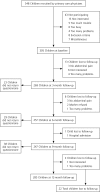Prognosis of abdominal pain in children in primary care--a prospective cohort study
- PMID: 23690323
- PMCID: PMC3659140
- DOI: 10.1370/afm.1490
Prognosis of abdominal pain in children in primary care--a prospective cohort study
Abstract
Purpose: Abdominal pain is a common complaint in children. Because few data exist on its natural history, we wanted to investigate the prognosis of abdominal pain in children in general practice.
Methods: In a prospective cohort study of children (aged 4 to 17 years) complaining of abdominal pain, follow-up was at 3, 6, 9, and 12 months using standardized questionnaires. The primary outcome measure was chronic abdominal pain: abdominal pain at least 1 time a month during at least 3 consecutive months that had an impact on daily activities. Prevalence, incidence, and duration of chronic abdominal pain were assessed.
Results: Three hundred five children (116 boys, 189 girls), with a median age of 7.8 years (interquartile range [IQR] = 5.7-10.5 years) were included. Chronic abdominal pain was present in 142 (46.6%) children at an initial visit to the primary care physician for this complaint. During follow-up, 78.7% fulfilled the criteria for chronic abdominal pain at 1 or more follow-up points. Among 163 children at risk for developing chronic abdominal pain, the cumulative incidence of chronic abdominal pain was 60.1% (95% CI, 52.1%-67.7%) and was higher in girls than in boys (RR = 1.23; 95% CI, 0.94-1.61). Median duration of abdominal pain was 7.5 months (IQR = 4.5-12.0 months). Children aged 10 to 17 years had the longest duration of abdominal pain (median = 9.0 months; IQR = 7.5-12.4 months). Children with symptoms of irritable bowel syndrome seemed to have a less favorable prognosis compared with children with symptoms of functional dyspepsia or functional abdominal pain.
Conclusions: The presence and development of chronic abdominal pain is common and of long duration among children consulting in primary care for abdominal pain. These poor outcome data warrant follow-up.
Keywords: child; chronic abdominal pain; epidemiology; primary care; prognosis.
Figures
References
-
- BEACH Program, AIHW General Practice Statistics and Classification Unit Presentations of abdominal pain in Australian general practice. Aust Fam Physician. 2004;33(12):968–969 - PubMed
-
- Chitkara DK, Rawat DJ, Talley NJ. The epidemiology of childhood recurrent abdominal pain in Western countries: a systematic review. Am J Gastroenterol. 2005;100(8):1868–1875 - PubMed
-
- Størdal K, Nygaard EA, Bentsen BS. Organic abnormalities in recurrent abdominal pain in children. Acta Paediatr. 2001;90(6):638–642 - PubMed
Publication types
MeSH terms
LinkOut - more resources
Full Text Sources
Other Literature Sources
Medical


